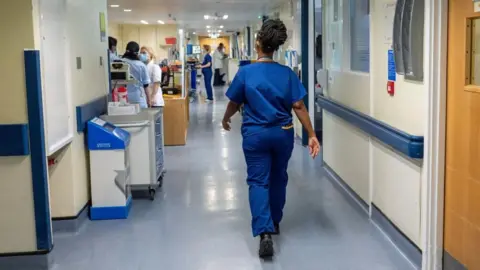Government unveils plan to cut NHS waiting list backlog
 PA Media
PA MediaThe government has unveiled a new pledge to cut the list of patients waiting more than 18 weeks for NHS treatment in England by nearly half a million over the next year.
The plan, to be announced on Monday, will expand access to Community Diagnostic Centres and surgical hubs, alongside reforms designed to enhance patient choice and tackle inefficiencies.
Prime Minister Sir Keir Starmer said it would create millions more appointments and “deliver on our promise to end the backlogs”.
The British Medical Association (BMA) has welcomed the plan but was sceptical about whether it could be delivered.
The government has billed the plan as an important milestone in a broader effort to reduce the number of people enduring long waits for appointments, procedures and surgeries.
Sir Keir added: “Greater choice and convenience for patients. Staff once again able to give the standard of care they desperately want to.”
A key Labour election pledge, now included in the government’s six main priorities, is for 92% of patients to begin treatment or be given the all-clear within 18 weeks by the end of this Parliament.
This has been an official NHS target for some time, but has not been met since 2015. Currently, only 59% of patients meet the 18-week target, with three million people waiting longer.
The latest promise is to reach 65% by March 2026, which, according to the government, would reduce the backlog by more than 450,000.
A network of Community Diagnostic Centres, which provide appointments such as scans and endoscopies in local neighbourhoods, will extend their opening hours to 12 hours a day, seven days a week.
The aim is to get patients treated more quickly, closer to home and without relying on hospitals. Officials say these centres will provide up to half a million extra appointments each year.
GPs will also be able, where appropriate, to refer patients directly to these centres without requiring a prior consultation with a senior doctor.
More surgical hubs will be created to focus on common, less complex procedures, such as cataract surgeries and some orthopaedic work. These hubs are ring-fenced from other parts of the hospital to ensure operating theatre time is not lost if there are emergency cases.
The new plan says that one million unnecessary appointments per year will be freed up for patients who need them. This will be made possible by abolishing automatic review appointments after treatment and only offering them to patients who request them.
Officials say the extra appointments created will be in addition to what was promised by Labour before the election. That pledge was for 40,000 more appointments per week, or two million a year, to be created within the first year.
This compares with a normal annual total of more than 100 million appointments. Ministers have confirmed that work on this pledge began soon after the election.
Plans for patients to use the NHS App to monitor and book consultations and test results, with greater control over where they are treated, have already been announced. The goal is to make the system more efficient and reduce the number of missed appointments.
NHS England Chief Executive Amanda Pritchard said: “The radical reforms in this plan will not only allow us to deliver millions more tests, appointments, and operations, but do things differently too – boosting convenience and putting more power in the hands of patients, especially through the NHS app.”
The overall waiting list for NHS appointments, procedures, and surgeries in England stands at just under 7.5 million.
No target level has been set in the plan, but ministers say that the waiting list will inevitably fall as measures to meet the 18-week benchmark take effect.
The funding for NHS England has been set for the upcoming year, but the additional money needed to support extra activity in hospitals will be outlined in the government’s spending review later this year.
Professor Phil Banfield, chair of the BMA Council, expressed doubt over whether the plan could be delivered.
“Doctors have been just as frustrated as their patients by the lack of facilities to deliver care and want to bring waiting lists down,” he said.
“But the reality is that without the workforce to meet constantly rising demand, we will not see the progress we all hope for.”
Ed Argar, Shadow Health and Social Care Secretary, said it was the Conservatives who “revolutionised” the diagnostic process by rolling out 160 Community Diagnostic Centres.
He said the government’s plan is “another announcement that makes clear after 14 years in opposition, the Labour Party have no new ideas of their own for the NHS – despite promising change”.
“Patients cannot wait for more dither and delay from the government who promised so much, and so far have delivered so little,” he said.
Liberal Democrat MP and health spokesperson Helen Morgan said the plan for waiting lists could risk “putting hip replacements over heart attacks”, unless the “crises” in emergency and social care were addressed.







